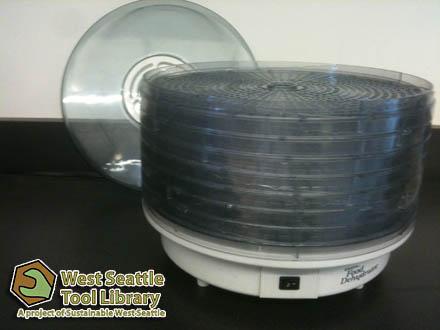West Seattle Tool Library Tool of the Week: The Food Dehydrator
Food Dehydrator
Sat, 04/02/2011
By Christina Hahs
When most people think of the West Seattle Tool Library, they probably imagine shovels and saws. While we have all of those available for use, we also have a collection of kitchen tools that can help you preserve the harvest. Tool #485 is an electric food dehydrator.
Dehydrators are great tools because they are so versatile. Drying can reduce large amounts of food into more manageable amounts. Drying also helps you preserve food without investing money into a freezer or time into canning. The dehydrator does most of the work for you, so you can spend more time using our other tools.
Some of our favorite ways to use a dehydrator:
Dried Fresh Fruit. Have an Italian plum tree or a bumper crop of grapes? Save some of that produce in the summer and enjoy it all winter long.
Dried Tomatoes. Nothing beats the taste of a fresh, vine-ripened tomato but a dehydrator can help you come close. Dehydrate your extra tomatoes and use them in soups, stews, and casseroles for that tomato taste in the winter.
Dried Vegetables. Dry your excess veggies for use in soups and casseroles. My favorite veggies to dry are onions, corn and zucchini. Some veggies, like zucchini, can be seasoned before drying to make a savory snack.
Save Leftovers Forever! Drying meals is a great way to preserve your extra food for when you need to eat quickly. Just add hot water and you’ve got dinner. Blended soups, pasta dishes, and casseroles are especially great for drying.
Create Your Own Backpacking Food
Love to backpack but don’t love paying exorbitant prices for the food? Dehydrate your own meals. You’ll save some cash and eat great. Dehydrated meals can also be used in an emergency preparedness kit, for when the next snowpocalypse hits.
Dried Herbs. Those little jars of dried herbs can be quite pricey. Preserving your excess herbs like basil and oregano can save you some cash and keep you in dried herbs all winter long.
Homemade Fruit Leather. Making your own fruit leather not only lets you cut out sugar and preservatives, but it also lets you make wild combinations. Think peach and blackberry or wild huckleberry. Don’t plan on any of this making it to winter though.
Jerky. Dehydrators can be used to make both meat jerky and tofu jerky.
Pet Treats. Don’t forget about Fido when using the dehydrator. Start making homemade treats like dried liver or dried filet mignon. You’ll have the happiest pet on the block.
Want to learn more about dehydrating food? Check out these great resources, available through Seattle Public Library:
Backpack Gourmet by Linda Fredrick Yaffe
The Busy Person’s Guide to Preserving Food by Janet Chadwick
The Electric Food Dehydrator is just one of over 1,000 tools currently available at the West Seattle Tool Library, which is free to use and run primarily on user donations. If you or someone you know you would like to be involved in The Tool Library, feel free to drop in on Saturdays from 9am-2pm or Sundays from 1-5pm to explore the Library, meet our community of DIYers, and even sign up for a membership. In any case, we would look forward to meeting you soon!
The Tool Library will operate until April 3rd at the LHO Complex off the North Entrance to South Seattle Community College, 6000 16th Ave SW. After that date, The Tool Library will move to its new location at Youngstown Cultural Arts Center, 4408 Delridge Way SW, with a grand re-opening on April 9th.
Not only will this new location quadruple the Tool Library’s square footage but it will also offer a community workshop space. All the more reason for you to visit your Tool Library and get involved.
Follow us on:
Facebook: www.facebook.com/WSToolLibrary
Twitter: @WSToolLibrary
and Meetup: www.meetup.com/West-Seattle-Tool-Library/
Email: library@sustainablewestseattle.org
Website: sustainablewestseattle.org/tool-library


